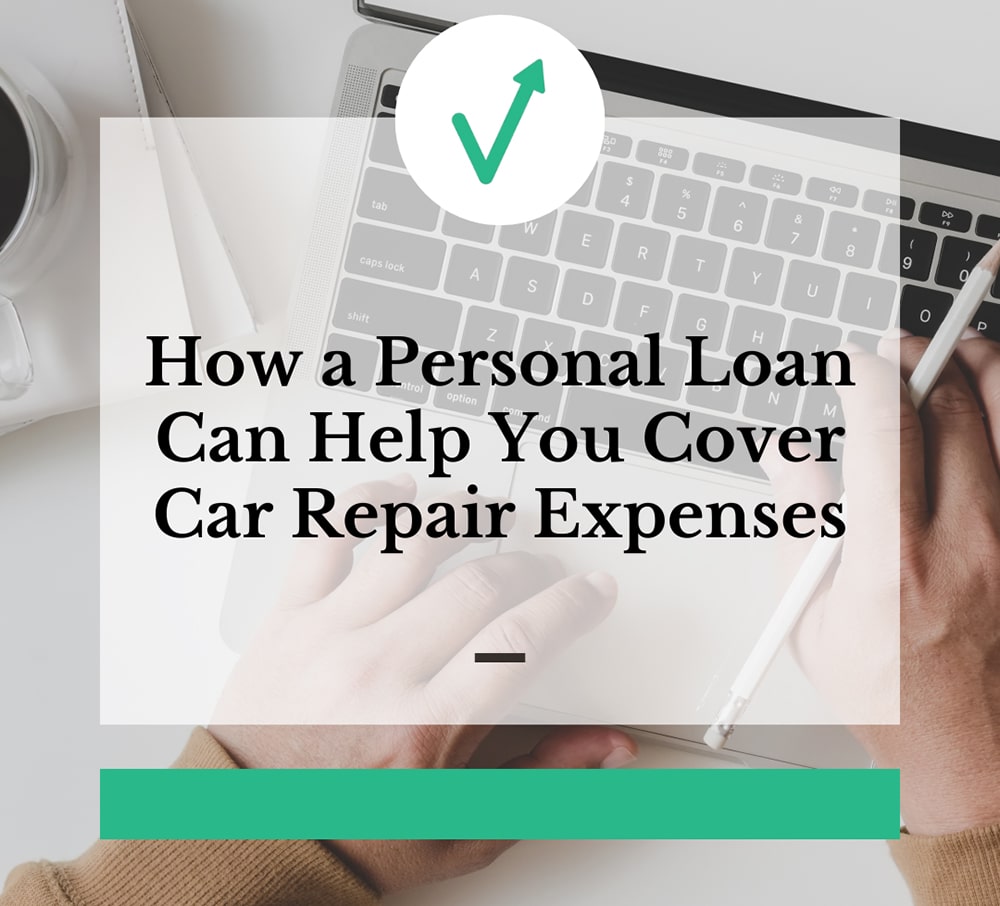Unexpected car repairs can put a major dent in your budget. One minute, you’re driving down the road, and the next, your car is sputtering and stalling, warning lights are flashing, or you’ve got a flat tire. Now, you’re facing a hefty auto shop bill just when you can least afford it.
Taking advantage of a personal loan may be a viable strategy to finance essential car repairs without turning to the burdens of credit card debt.
These loans come with definite interest rates and repayment periods, granting you the ability to spread the expenses over time via manageable monthly installments. With insightful preparation and detailed study, a personal loan stands as a feasible method of financing to ensure your vehicle is up and running swiftly.
What are Personal Loans?
A personal loan is a specific example of an installment loan; here, you lend a definite amount of funds upfront, which is repaid across a prescribed duration through uniform monthly installments. These loans can be availed for any purpose, lending expansive flexibility when it comes to expenditures such as vehicle maintenance.
Personal loans involve borrowing from financial institutions like banks, credit unions, or digital lenders. These lenders offer you a one-time payment of cash or a ‘lump sum’. Month after month, you repay this lump sum, inclusive of interest, until the entire amount is paid off.
Terms of interest rates, fees, period, and other such conditions vary by lender. However, the typical model of a personal loan functions as follows:
- Loan amount: $1,000 to $50,000
- Interest rate: 5% to 36%
- Loan duration: 1 to 7 years
- Origination fee: 0% to 8% of the loan amount
- Credit check: Necessary
- Monthly installment: Fixed across the period of the loan
Key Takeaway: Personal loans offer a structured way to borrow money, making them ideal for financing essential expenses like car repairs.

Advantages of Personal Loans for Auto Repair
Here are a few compelling reasons to contemplate leveraging a personal loan to cover the costs associated with automobile maintenance:
- Unified Expenditures: Personal loans allow you to unite the charges required for repairing in one, single, predictable monthly invoice, excluding the need to spread costs across different credit cards.
- Reduced Interest: Personal loans generally showcase significantly lower interest rates than credit cards, which often surpass 15% or even escalate to 20% in Annual Percentage Rate (APR).
- Stable Repayments: Personal loans come with a set repayment tenure, encapsulating consistent monthly installments. This measure aids in maintaining smooth and manageable expenses.
- Improve credit – Making on-time payments shows responsibility and helps improve your credit score.
- Any purpose – Personal loans provide cash that can be used for any legal purpose. Car repairs, medical bills, home repairs – it’s up to you!
Key Takeaway: Personal loans are a viable option for covering car repair expenses due to their structured repayment plan, lower interest rates, and flexibility. They can also help improve your credit score if you make timely payments.
Things to Consider Before Applying for a Personal Loan
Personal loans offer a sensible way to finance major expenses when used carefully! Before you apply for a loan, think through these key points.
Credit Score Requirements
Most lenders require borrowers to have good to excellent credit for approval and low rates. Here are typical credit score requirements.
- Good credit – Scores of 670 to 739
- Very good credit – Scores of 740 to 799
- Excellent credit – Scores of 800-plus
If your score is under 670, you may have trouble qualifying, or only get expensive subprime loans. In that case, spend some time improving your credit before applying.
Comparing Loan Offers
Don’t just accept the first loan you’re offered! The differences between lenders can really add up. Carefully compare at least 2 to 3 offers before deciding.
- Interest rates – Even a couple of points can equal hundreds in savings
- Origination fees – Some loans have no fees, while others charge up to 8%
- Monthly payments – Will they really fit your budget? Crunch the numbers
- Penalties – Check for prepayment penalties that add extra costs
Take the time upfront to understand the full costs and find your most affordable option.
Total Costs
Look beyond just the monthly payment. Make sure you can afford the loan’s total costs over its full term.
- Interest paid – Will depend on the rate and loan length
- Fees – Origination fees and other admin costs
- Insurance – Some loans require credit insurance
Add it all up to see the true total cost of borrowing. Only take out what you can manage.
Key Takeaway: Before applying for a personal loan, check your credit score and compare offers from different lenders to find the most affordable option. Consider not just monthly payments but total costs over the loan’s entire term.

Steps to Apply for a Personal Loan
Decided to progress with applying for a personal loan? Here’s a systematic instruction guide detailing the workflow.
Select Your Lender Wisely
Kick-off by investigating potential lenders and choosing one to coordinate with. Appealing options encompass:
- Your existing banking institution or credit union
- E-lenders such as LendingClub or Prosper
- Peer-to-peer lending platforms like Upstart or SoFi
Weigh up interest rates, service charges, loan amounts, and eligibility criteria. Settle for a lender that resonates with your requirements.
Assemble Necessary Documentation
Prepare to furnish the following documentation:
- Identification proof – Examples include driver’s license, passport, and so on.
- Verification of income – You’ll need documents like pay slips, tax returns, and bank statements.
- Employment details – Information about your job history and annual income.
- Assets and debts – Details from your credit report and account balances.
Having your documents neatly arranged can streamline the application process significantly.
Fill Out the Application
The application form will solicit the following details:
- Personal Information: This covers your name, residential address, Social Security Number, and date of birth.
- Employment Status: Your job designation, the name of your employer, and the duration of your employment.
- Income and Expenditure: Monthly amounts relevant to each.
- Assets and Liabilities: Details such as your home value, retirement savings, and outstanding credit card balances.
To avoid delays or rejections, answer every query in a thorough and truthful manner.
Submission and Subsequent Waiting Period
Upon submission of your application, the lender will:
- Analyze your submitted details
- Execute a hard credit check
- Authenticate your income, debts, and assets
- Reach a loan decision
Typically, this process spans 1 to 5 business days.
Confirm Your Loan Offer
If your application receives approval, you will obtain a loan offer detailing the:
- Principal Loan amount
- Applicable interest rate
- Associated fees
- Tenure of the loan term
- Monthly payment
After acceptance, your loan funds will be distributed, often within a week. Then, you can get those essential car repairs taken care of.
Key Takeaway: When you’re ready to apply, choose a lender that meets your needs, gather the required documentation, and fill out the application honestly. After reviewing your details, the lender will provide a loan offer detailing key terms such as loan amount, interest rate, and monthly payment. Once accepted, funds are typically distributed within a week.
Alternatives to Personal Loans
Personal loans offer one solution for financing major car repairs. But make sure to explore all your options before deciding:
Savings
Using available savings is often the cheapest option, even if it empties your account. You avoid borrowing costs and get back on the road faster.
Credit Cards
Putting repairs on a credit card lets you pay later. But double-digit interest rates can pile on costs over time. And you need to make more than the minimum payment each month.
Auto Repair Financing
Some repair shops offer their own in-house financing programs. These can be convenient but also feature high-interest rates. Shop around and compare costs.
Borrowing from Family/Friends
An interest-free loan from family or friends is great if available. Just be sure to agree on repayment terms upfront to avoid issues later. Compare all these alternatives to decide if a personal loan is your most affordable path forward.
Key Takeaway: Personal loans may not be the only option for financing car repairs. Consider using savings or credit cards, seeking out auto repair financing, or borrowing from family/friends before taking out a loan. Weigh the costs and benefits of each option to make an informed decision. Overall, understanding your options and carefully comparing them can help you find the most affordable solution for your specific needs.

Final Thoughts
With low fixed rates, predictable payments, and flexible terms, a personal loan simplifies borrowing. Paying interest is certainly cheaper than lacking reliable transportation or being burdened with sky-high credit card balances. Just be sure to only borrow what you can comfortably manage each month.
Level provides a compelling combination of competitive rates and a simple, streamlined online application process. Their commitment to customer convenience and affordability makes them a strong contender in the personal loan landscape. Remember, the goal is to secure a loan that meets your immediate needs while maintaining long-term financial health. So, why wait? Begin your journey toward financial flexibility today with a Level personal loan.




